Sex, dogs, and tragedy in Pompeii
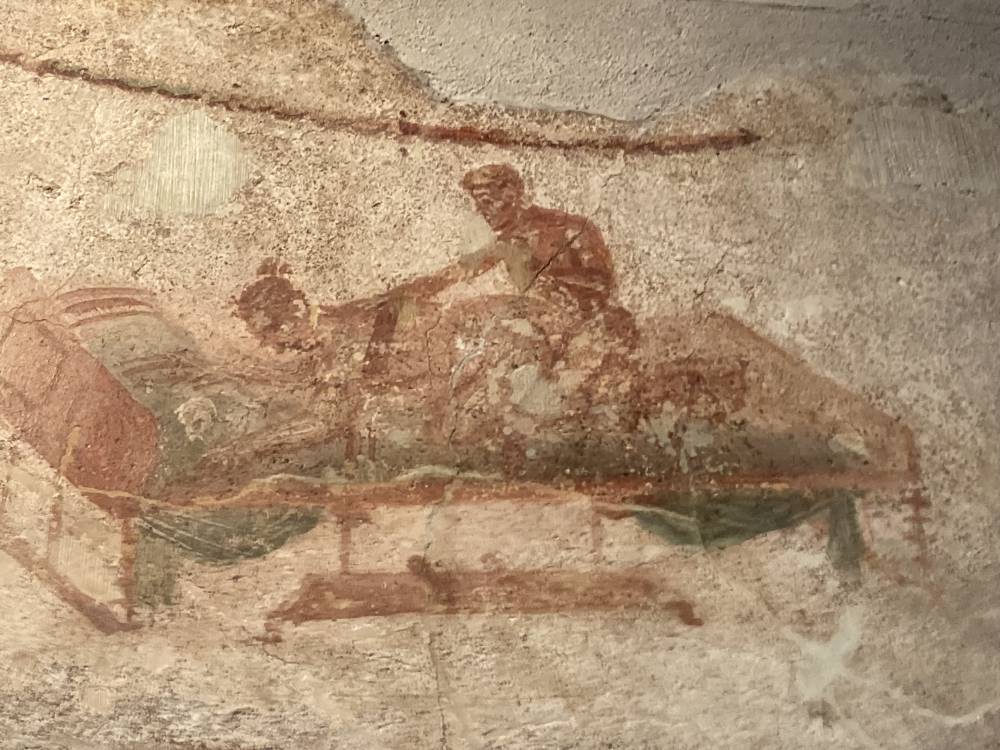
Maybe it’s the voyeur in all of us, mesmerized by carnage and scandal, even as we cover our eyes. I actually grew up mesmerized by documentaries on what happened to Pompeii, the Italian city buried under as much as 20 feet of ash and stone when Mount Vesuvius unexpectedly erupted with tremendous fury in 79 AD. I imagined seeing up close those bodies, preserved at the very moment they were suffocated in burning lahar.
Last November, I found myself in Naples for work, and had completely forgotten that Pompeii was nearby—a 3-Euro, 25-minute train ride away, in fact. Thus did a childhood dream come true: I got to play historical nerd/voyeur for real.
I suggest doing what I did, booking a short tour with an archeologist or archeology student who can point out interesting details, and since the entrance ticket has no time limit, spend the rest of the time visiting or revisiting spots you want to see. Also, there’s a separate entrance for tours, although it being the low season, the lines were not crazy. Our guide, Anna, a student, was well-informed and funny.
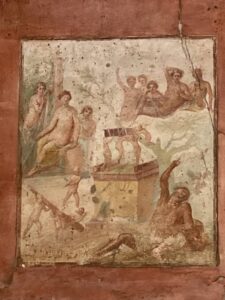
Oh, and of course, wear comfortable shoes, as the excavated area of Pompeii you can tour covers 44 hectares, not even counting the Villa of Mysteries located about half a kilometer from the gated ruins.
By all accounts, Pompeii was a party place (thus, the implications of it being a latter-day Sodom and Gomorrah that had the wrath of God coming), a wealthy town of some 20,000 people, with several mansions filled with artworks—in particular, gorgeous frescoes which remain vibrant to this day. The functions of the existing spaces are very clear—a shop or little restaurant here, a humble home there, and, gasp, a brothel right over here (that will, er, come later).
According to the American Museum of Natural History, the violent eruption lasted two days, also covering nearby Herculaneum. It was enough to make me throw respectful glances at Vesuvius, still reportedly active, on the horizon. Pompeii was declared a Unesco World Heritage Site in 1997.
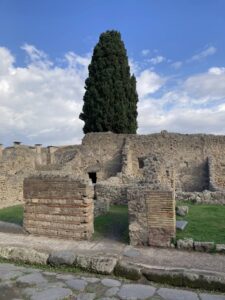
Well-zoned
I got goosebumps walking through the main gate, wide enough to fit the carriages that entered the streets. Indeed, the streets remain haunting in this well-zoned place, evocative of the once-flourishing life here. You first come upon the vast Forum, the equivalent of a central square for public events, markets, and as a location for temples of worship. There are also the columns that remain of the Basilica—not a church, but a court of law where cases were heard. Near the Forum is the Sanctuary of Apollo, a temple dating back to 120 BC and dedicated to the Roman god.
Several thermopilia, what they called restaurants or food houses, have holes for fires that warmed the pots of food for people to take away; smaller houses with one or two small rooms where regular citizens lived are also relatively intact. There is even a baker’s house, with a brick oven.
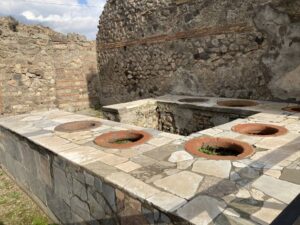
The aptly named Via dell’Abbondanza (street of abundance), however, was the address of more stately homes, including the House of Loreius Tiburtinus (also called the house of Octavius Quartio), adorned with beautiful frescoes made using precious pigments. Other homes had spacious gardens, with fountains and other features; one even had a wine cellar.
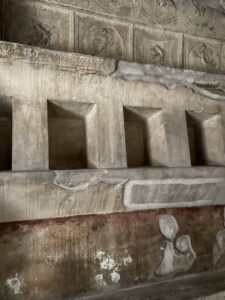
Public bathing was quite a Roman thing, and the Stabian Baths is the largest complex, and probably one of the oldest in the world, believed to have been constructed back in 125 BC. Men’s and women’s baths are separate (with the men’s area being bigger), each with its own apodyterium (changing room) complete with open shelves in the stone for lockers.
I had visions of gladiators in combat at the expansive grand theater of Pompeii (not to be confused with the amphitheater, where Pink Floyd actually recorded a concert in 1972); in fact, Anna informed us, there are gladiators’ quarters behind the stage, which has beautiful trees for a backdrop, including the towering cypresses one sees all over the place. Here they also held theatrical and musical performances, and it’s apparently still a performance venue to this day.
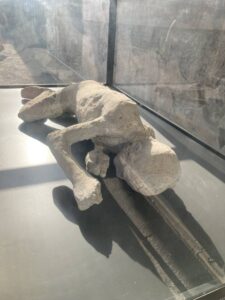
Frozen in time
I also finally set eyes on the famous victims of Pompeii, human bodies frozen in time after being submerged in the pyroclastic flow, preserved in a moment of agony. To set the record straight: These are not actual bodies entombed in hardened lava. Instead, excavators removed the bodies and filled the negative space with plaster to create molds of the victims. Most of the “victims” have been relocated, although one place, the aforementioned House of Loreius Tiburtinus, features bodies of those who died found in situ.
Like I mentioned, Pompeii was Sin City, and seafaring traders as well as visitors from Rome and other places came here to have fun. One leading source of entertainment: prostitution, with at least 25 brothels discovered during the excavations, according to the tourism information site pompeiitours.it. Prostitution was legal, and brothels (called lupanar by the Romans, meaning “wolf’s den,” as the working girls were also referred to as “lupa” or she-wolves) functioned just like any other shop. Anna pointed out some graffiti, scratched on stone from antiquity, advertising the services of a “Libania fellati” (Google it, dear reader, if you must), as well as directional signs on some posts pointing the way to the brothel—in the form of a phallus, a man with a distended phallus, and other such unsubtle iterations.
Inside the most famous two-storey lupanar are also a number of fine erotic frescoes, purportedly added to put customers in the mood (or give them ideas), or even as some sort of menu of available services. Finally, unlike other beds made of wood, the beds in the lupanar’s rooms, which were closed off with curtains, Anna said, were made of stone so they were easier to clean, although mattresses were supposed to have cushioned them.
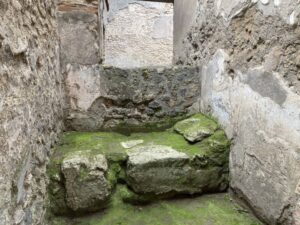
Beware of dog
The pompeiitours.it site emphasizes, however, that these prostitutes, as expected, lived difficult lives, as they were often slaves kicked out by the lupanar when they were no longer popular, with brothel owners keeping most of their earnings. They were also discriminated upon enough to not have options after leaving the trade.
After the tour, I asked Anna to point me to a place I had long wanted to see: the House of the Tragic Poet, famous for some of the most beautiful mosaics and frescoes in the archeological site. The remains of a real dog had actually been found in another place, the House of Orpheus, still chained to his post and buried under the eruption. Unlike the poor real animal, the mosaic version at the House of the Tragic Poet remains preserved at the entrance, in mainly black and white tiles, ready to attack intruders, they said (although the animal seems poised in what is now known to be a playful pose for a dog).
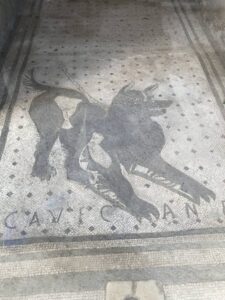
Below the animal, the sign “Cave Canem” (beware of dog) discourages trespassing. It’s a remarkable art piece that has stood the test of time. The house itself was closed for restoration, but I still got a good view of the dog through protective glass.
Excavation only began in earnest in Pompeii in the 16th century, but it continues to this day, which is why students like Anna are blessed to have a treasure of a playground to work on. In January 2021, a bronze chariot was found north of Pompeii. Also that year, a painted tomb containing the mummified remains of a temple custodian was discovered.
Just last year, more frescoes, including a priceless one showing Helen of Troy and Paris, as well as a shrine with paintings of females representing the four seasons, were unearthed nearby.
Pompeii is a gift that keeps on giving. It is heartening to know that, in the aftermath of ancient destruction, such history and art live on for the world to see.

















